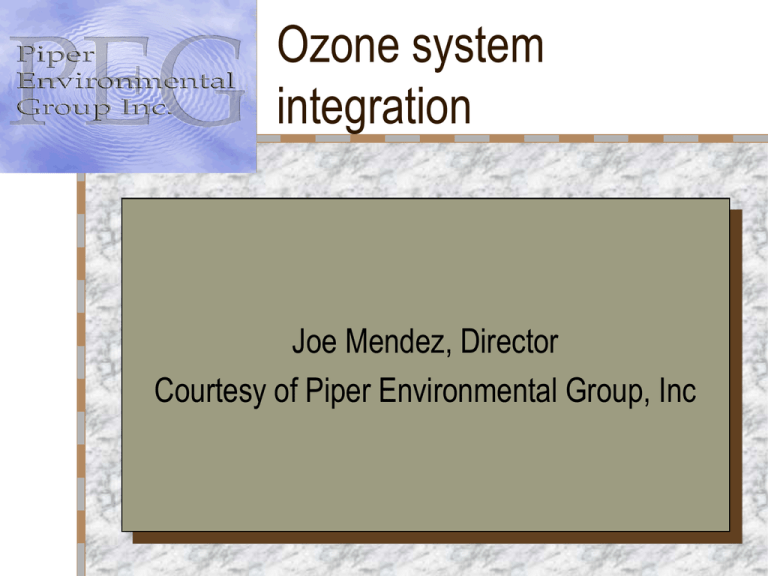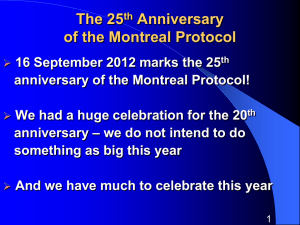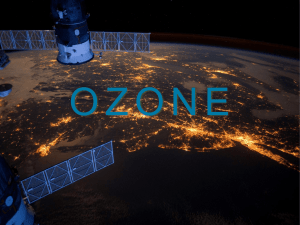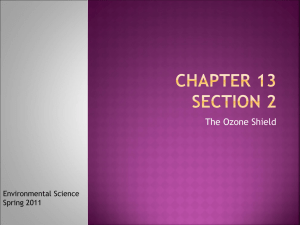Integration presentation
advertisement

Your Logo Here Ozone system integration Joe Mendez, Director Courtesy of Piper Environmental Group, Inc Overview of Class Provide you with the basic concepts of ozone system integration. You will not be an “expert”, but you will understand the basic components and their integration. Component Descriptions Feedstock gas Ozone Generator Injection system Contact vessel Degas Destruct Instrumentation and Controls Cobb Water District - System Diagram Demister ClearWater Tech CD4040 HO Ozone Generator Ozone Destruct Unit Armstrong AV-3 Gas vent GDT Corp. DS – 100 WM Degasser System Pump 30 gpm Ozone Contact Tank 16 gal. capacity Mazzei Injector with By pass Finished Water ORP Controller Fe < 0.1 ppm Mn ~ 0.05 ppm Graduated Media Filter 110 gal By pass Flow rate 140 GPM of Well Water Fe = .58ppm Mn = .12ppm Feedstock gas Air. – Must be clean and very dry. Typical dew point of 800F – At a dew point of - 200F about 50% of the output of the ozone generator will be lost – Will produce Nox which in the presence of moisture will produce Nitric Acid which corrodes Stainless Steel – Source of compressed air must be oil vapor free. Feedstock gas - continued Oxygen. - Minimum purity 90% oxygen with a dew point of - 1000F – Bottled oxygen - not recommended, except for short, less than one day, tests. – Liquid oxygen - not recommended for residential. OK in commercial and industrial use for short term demonstrations and pilot studies. – Oxygen generators - Will typically pay for themselves in less than 18 months. Require about 10 to 12 scfm of compressed air per scfm of oxygen. • Low pressure systems - less than 10 psig - small ozone generators - AIRSEP and SEQUAL. • High pressure systems - up to 100 psig - large ozone generators - AIRSEP, OGSI, OXAIR, etc. – Be aware of fire problems specially in large units Ozone generators UV - not suitable for water treatment. Output is about .1% ozone by weight. Used in Spas. Corona discharge - suitable for water treatment. Output range of 1 to 18% ozone by weight. Output, Concentration and Flow. What is their relationship? – (G/hr) X (0.0755) / ( % conc.) = Nm3/hr Ozone generators - continued Variants of CD ozone generators. – Frequency - Low frequency (60 Hz), Medium frequency (1000 Hz) and High frequency (10,000Hz) – Cooling - Air or water cooled – Operating pressure - Vacuum, 10 to 15 psig and20 to 30 psig – Size - Small (<10 PPD), medium (>10 to 150 PPD) and large (>150 PPD to one ton per day) – Feedstock gas - Air or oxygen Ozone injection Bubbling or direct injection – Low mass transfer efficiency – Takes a lot of real estate – Subject to water back-flowing into generator Eduction - Venturi effect (Mazzei injectors) – High mass transfer efficiency – Compact foot print – Subject to water back-flowing into generator Contact vessel A tank or length of pipe designed to allow the ozone gas and the water to mix for about 30 seconds to 1 minute. It improves mass transfer of the ozone. Residential - Fiberglass tank in the 20 to 40 gallons range. Commercial/Industrial - 304 stainless steel tank in various size ranges. Degas system Residential - Typically a stainless steel vent valve on top of the contact vessel. Allows the un-dissolved gasses, including excess ozone to be vented from the top of the tank. Commercial / Industrial - Typically an additional stainless steel vessel that imparts centrifugal force on the water and separates it from the un-dissolved gasses. They in turn are vented through a stainless steel vent valve. GDT System is a patented separator device. Due to cost, it is not used in a residential or light commercial environment. Destruct system The purpose of a destruct system is to destroy any excess ozone in the off gas. Ozone is a Toxic Gas and an EPA listed pollutant. It should not be vented into the atmosphere. Variants of ozone destruct units – Temperature only - Expensive to operate. Requires a minimum of 5000F for quick (<1 sec.) destruction. – Catalyst only - Inexpensive to operate. Requires that gas flow be de-misted to remove excess moisture. Moisture will destroy the catalyst and Sulfur will poison it. – Combination units - Most widely used. Uses a small heater to dry the gas stream and catalyst to complete the destruction. Instrumentation and controls Instrumentation -The purpose of instrumentation is to allow the user or operator to be aware of the operating conditions. Instrumentation can be hand held or fixed. It can also be chemical or electronic. Controls - The purpose of controls is to allow for the automatic control of the ozone generator and associated equipment. Instrumentation and controls continued Dissolved ozone - Colorometric - DPD Chlorine or Indigo Blue. About $75 in cost. Readings up to 2.3 ppm. Used to indicate spot readings. Dissolved ozone - Electronic - wet cell without reagents. About $3,000 in cost. Readings up to 15 ppm. Typically used to indicate and to control ozone generator output. Most typically used in industrial and high end commercial applications. ORP - Oxidation Reduction Potential. Less than $1,000 in cost. It is used as both an instrument and a control. It can control ozone generator output. Readings are expressed in mV (millivolts). European standards declare that water is sanitized after it reaches a reading of 750 mV of ORP. Most typically used in commercial and high end residential applications. Methods of integration Factory systems. The system is integrated for you and it is delivered as a complete package. Lends itself to small systems under 20 gpm. Typically used in the residential and light end commercial environment. Self integrated systems. This requires a much higher level of expertise. It requires knowledge of pumps, injection systems, contacting, degassing and controls. It requires the ability to assemble the entire system from various pieces and vendors. The amount of capital required for this level also increases dramatically, with the size of the ozone generator. An integrator is usually a “Distributor”, and they take ownership of the equipment, so the integrator must have the ability to finance the equipment until paid by the end user. Questions?








